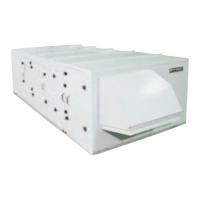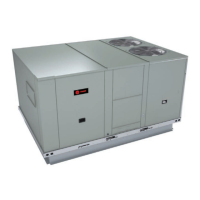52 FAXA-SVX01B-EN
Unit Startup Procedures
1. Check all electrical connections for
tightness.
2. Be sure all system components are
properly set and installed.
3. Inspect all ductwork and duct
connections.
4. Remove compressor and fan
assembly tie down bolts.
5. Verify the total energy wheel seal
doesn’t leak. See procedure below.
To start the unit, complete the following
list in order:
1. Apply power to the unit. Close the unit
disconnect switch(es).
2. Adjust setpoints at the HI.
3. Turn on the gas if unit has gas heaters
and verify all lines are purged of air.
See the
Packaged Fresh Air Unit Pro-
gramming Guide, FAXA-SVP01B-EN,
for
available unit operating setpoints. Refer
to the job specifications for proper
setpoints.
Total Energy Wheel Sealchecks
The total energy wheel has a neoprene
bulb seal to provide an effective seal in
both the peripheral and side-to-side
sealing directions. Also, it is easily
adjustable to compensate for seal run-in,
shipping misalignment, etc. The neoprene
bulb is attached to a metal reinforced U-
shaped neoprene grip. The metal/
neoprene grip allows an expandable grip
range that can be moved closer or
further from the sealing face as needed.
The peripheral bulb seals against the
wheel outer band the inner bulb seals
against the wheel face.
Follow the procedure below:
1. With the wheel stopped, move seals as
close to the sealing surface as possible
but without exceeding grip range of
bulb seal and without pressing the bulb
down against the seal face.
2. Bump the motor. If the motor will not
turn, the seal is too close. Nudge it back
where needed. The seal will seek its
equilibrium position based on the
closest part of the sealing face.
Because the seal is meant to be a
noncontact seal, small gaps may be seen
between seal and sealing surface when it
reaches the equilibrium position. Seal
leakage is meant to be under 5% at one-
inch of differential between supply and
exhaust. Some seal run-in is common
and will result in small amounts of wear
in the neoprene.
Unit Startup Checklist
1. Ensure all fans rotate is in the direction
of the arrow on the fan housing. If
rotation is incorrect, first verify the
incoming power phasing is correct. If it
is correct, switch wires on the fan
contact so the fan is properly phased.
2. Check the fan belt condition and
tension. Adjust the tension if belts are
floppy or squeal continually. Replace
worn or fraying belts in matched sets.
3. Check voltage at all compressor
terminals. Actual voltage should be
within 10% of nameplate voltage.
4. Check voltage imbalance from these
three voltage readings, at each
compressor. Maximum allowable
voltage imbalance, phase to phase, is
2%.
startupInstallation

